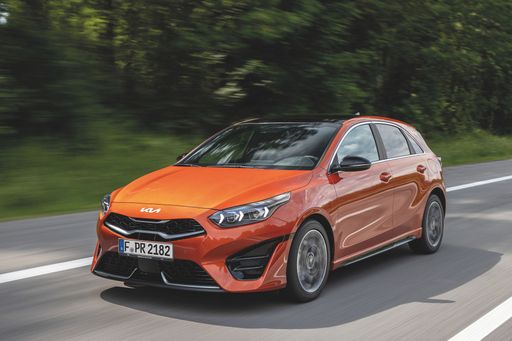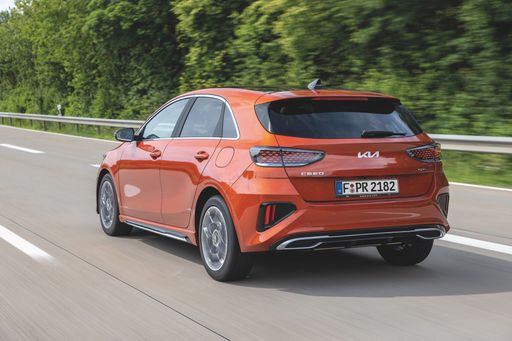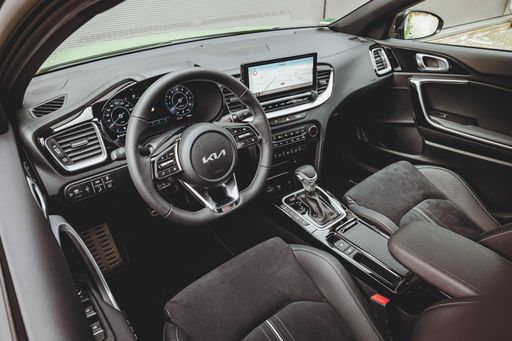Kia Ceed vs Maxus Deliver 9 – Differences & prices compared
Compare performance, boot space, consumption and price in one view.
Find out now: which car is the better choice for you – Kia Ceed or Maxus Deliver 9?
The Kia Ceed (Hatchback) comes with a Petrol MHEV or Petrol engine and Automatic or Manuel transmission. In comparison, the Maxus Deliver 9 (Cargo Van) features a Diesel or Electric engine with Manuel or Automatic transmission.
When it comes to boot capacity, the Kia Ceed offers 395 L, while the Maxus Deliver 9 provides – depending on how much space you need. If you’re looking for more power, decide whether the 140 HP of the Kia Ceed or the 204 HP of the Maxus Deliver 9 suits your needs better.
In terms of consumption, the values are 6 L per 100 km for the Kia Ceed, and 26.20 kWh8.80 L for the Maxus Deliver 9.
Price-wise, the Kia Ceed starts at 23100 £, while the Maxus Deliver 9 is available from 38700 £. Compare all the details and find out which model fits your lifestyle best!
Kia Ceed
The Kia Ceed stands out in the compact car segment with its sleek design and impressive handling. It offers a comfortable and well-equipped interior that appeals to both drivers and passengers. With its efficient engine options, the Ceed provides a smooth and enjoyable driving experience suitable for city commutes and longer journeys alike.
details @ press.kia.com
@ press.kia.com
 @ press.kia.com
@ press.kia.com
 @ press.kia.com
@ press.kia.com
Maxus Deliver 9
The Maxus Deliver 9 presents itself as a robust and versatile vehicle, perfectly suited for both urban and rural deliveries. With a spacious cargo area and a modern cabin equipped with advanced technology, it caters to the needs of both driver comfort and logistical efficiency. Its sleek design and reliable performance make it an attractive option for businesses looking to upgrade their fleet.
details

|
|
|
|
|
Costs and Consumption |
|
|---|---|
|
Price
23100 - 31300 £
|
Price
38700 - 60200 £
|
|
Consumption L/100km
6 - 6.4 L
|
Consumption L/100km
8.80 L
|
|
Consumption kWh/100km
-
|
Consumption kWh/100km
26.2 - 30.8 kWh
|
|
Electric Range
-
|
Electric Range
287 - 358 km
|
|
Battery Capacity
-
|
Battery Capacity
-
|
|
co2
137 - 146 g/km
|
co2
0 - 231 g/km
|
|
Fuel tank capacity
50 L
|
Fuel tank capacity
-
|
Dimensions and Body |
|
|---|---|
|
Body Type
Hatchback
|
Body Type
Cargo Van
|
|
Seats
5
|
Seats
3 - 7
|
|
Doors
5
|
Doors
4
|
|
Curb weight
1298 - 1372 kg
|
Curb weight
2360 - 2770 kg
|
|
Trunk capacity
357 - 395 L
|
Trunk capacity
-
|
|
Length
4315 - 4325 mm
|
Length
5546 - 5940 mm
|
|
Width
1800 mm
|
Width
2062 mm
|
|
Height
1442 - 1447 mm
|
Height
2525 - 2755 mm
|
|
Payload
478 - 500 kg
|
Payload
730 - 1140 kg
|
Engine and Performance |
|
|---|---|
|
Engine Type
Petrol MHEV, Petrol
|
Engine Type
Diesel, Electric
|
|
Transmission
Automatic, Manuel
|
Transmission
Manuel, Automatic
|
|
Transmission Detail
Dual-Clutch Automatic, Manual Gearbox
|
Transmission Detail
Manual Gearbox
|
|
Drive Type
Front-Wheel Drive
|
Drive Type
Front-Wheel Drive
|
|
Power HP
100 - 140 HP
|
Power HP
148 - 204 HP
|
|
Acceleration 0-100km/h
9.5 - 13.2 s
|
Acceleration 0-100km/h
16 - 19 s
|
|
Max Speed
178 - 197 km/h
|
Max Speed
100 - 160 km/h
|
|
Torque
172 - 253 Nm
|
Torque
330 - 375 Nm
|
|
Number of Cylinders
3 - 4
|
Number of Cylinders
4
|
|
Power kW
74 - 103 kW
|
Power kW
108 - 150 kW
|
|
Engine capacity
998 - 1482 cm3
|
Engine capacity
1996 cm3
|
General |
|
|---|---|
|
Model Year
2024
|
Model Year
2022 - 2024
|
|
CO2 Efficiency Class
E
|
CO2 Efficiency Class
G, A
|
|
Brand
Kia
|
Brand
Maxus
|
Kia Ceed
Discovering the Kia Ceed: A Symbol of Modernity
In the dynamic world of automotive engineering, Kia has consistently stood out with its innovative and reliable models. The Kia Ceed is no exception, bringing a blend of efficiency, style, and cutting-edge technology to the table. Let's delve into the details of this eye-catching hatchback and uncover what makes it an alluring choice for modern drivers.
Power and Performance: Under the Hood
The Kia Ceed is equipped with an impressive range of powertrains, offering a selection between petrol engines and mild-hybrid technology. The engine lineup boasts power outputs from 100 to 140 PS, catering to both economical driving needs and those seeking a bit more thrill on the road. The engine choices are complemented by either a smooth manual transmission or a state-of-the-art dual-clutch automatic, ensuring an engaging driving experience tailored to individual preferences.
Efficient and Eco-Friendly Engineering
Kia's dedication to eco-friendliness is evident in the Ceed's engineering, offering remarkable fuel efficiency between 6 to 6.4 L/100km. This focus not only keeps running costs low but also helps reduce emissions, maintaining a responsible footprint with CO2 emissions ranging from 137 to 146 g/km. This efficient performance ensures the Kia Ceed is both a financially savvy and environmentally considerate choice.
Advanced Technologies and Safety Features
Innovation is at the heart of the Kia Ceed's design, with a suite of advanced technological features enhancing comfort and safety. The latest driver-assist systems help keep occupants secure, providing confidence on every journey. Lane Keeping Assist, Forward Collision Warning, and Intelligent Speed Limit Assist are just some of the high-tech features that work seamlessly in the background, making driving both safer and more relaxed.
Styling and Comfort: A Perfect Cabin Space
Stepping into the Kia Ceed, drivers and passengers are greeted by a sophisticated interior, designed for comfort and style. Seen in multiple variants including the Nightline Edition and GT Line, the Ceed offers a premium feel across all its models. With dimensions that promise ample space—stretching up to 4325 mm in length and offering a boot capacity between 357 to 395 L—the Ceed perfectly accommodates both daily commutes and adventurous getaways.
Value for Money: A Wise Investment
Balancing a competitive initial outlay, ranging from €25,590 to €35,090, with low running costs, the Kia Ceed redefines value for money. This hatchback's adaptability to various lifestyle needs, paired with monthly costs from €887 to €1,019, positions it as a wise investment in the current automotive market.
Conclusion: The Kia Ceed in a Nutshell
The 2024 Kia Ceed superbly combines power, efficiency, and cutting-edge innovations, making it a noteworthy contender in the hatchback segment. Whether it’s the eco-friendly credentials, advanced safety systems, or the blend of practicality and style, the Kia Ceed is primed to lead the way in the evolving era of modern vehicles.
Maxus Deliver 9
A Versatile Workhorse: The Maxus Deliver 9
The Maxus Deliver 9 is rapidly gaining traction in the commercial vehicle sector. As a versatile and capable van, it meets the needs of a range of industries, providing both diesel and electric powertrains. The model year updates from 2020 to 2023 bring a host of technical advancements and innovative features that make the Maxus Deliver 9 stand out in its class.
Powertrain Options: Diesel and Electric
The Maxus Deliver 9 offers a choice between traditional diesel and modern electric powertrains. The diesel variant comes with a 2.0-litre engine, delivering 148 PS and a torque of 310 Nm. It is available with both front and rear-wheel drive configurations, coupled with a manual gearbox. These options provide robust and reliable performance for traditionalists who favour a dependable diesel setup.
For those looking to the future, the electric eDeliver 9 offers compelling specifications. With a power output of 204 PS and torque reaching 375 Nm, the electric version provides a silent and efficient drive. Battery capacity options cater to different needs, with ranges spanning from 265 km to an impressive 328 km depending on the chosen battery configuration. This makes the eDeliver 9 a viable choice for urban and regional deliveries.
Innovative Features for Enhanced Utility
The Maxus Deliver 9 is equipped with features designed to enhance practicality and comfort. With a payload capacity ranging from 630 to 1275 kg, it is well-suited for various commercial applications. The model’s dimensions and configurable seating options (accommodating between 3 to 7 passengers) add flexibility, making it ideal for both logistics and passenger transport roles.
Despite its work-focused design, the Deliver 9 doesn’t skimp on creature comforts. The cabin offers a modern infotainment system with touchscreen capabilities, providing intuitive control over navigation and connectivity functions. Advanced safety features, including lane departure warning and adaptive cruise control, are available, ensuring peace of mind for drivers and fleet managers alike.
Environmental and Economic Efficiency
In an era where sustainability is paramount, the Maxus Deliver 9 delivers low operating costs and reduced environmental impact, particularly in its electric form. The electric models boast zero tailpipe emissions and CO2 efficiency class ratings up to A, making them an attractive choice for green-conscious businesses.
From an economic standpoint, the electric variants also offer long-term savings through reduced fuel costs and maintenance requirements compared to their diesel counterparts. Initial pricing for the Deliver 9 ranges from €43,423 to €93,403, depending on the specification and powertrain, representing competitive value within the segment.
Conclusion: Meeting Modern Transport Needs
The Maxus Deliver 9 represents a compelling proposition in the commercial vehicle market. With its blend of diesel and electric powertrains, innovative features, and a focus on efficiency, it meets the diverse needs of modern businesses. Whether prioritising traditional power or embracing new technologies, the Deliver 9 offers a versatile choice that businesses can rely on for both present and future transportation needs.
The prices and data displayed are estimates based on German list prices and may vary by country. This information is not legally binding.
